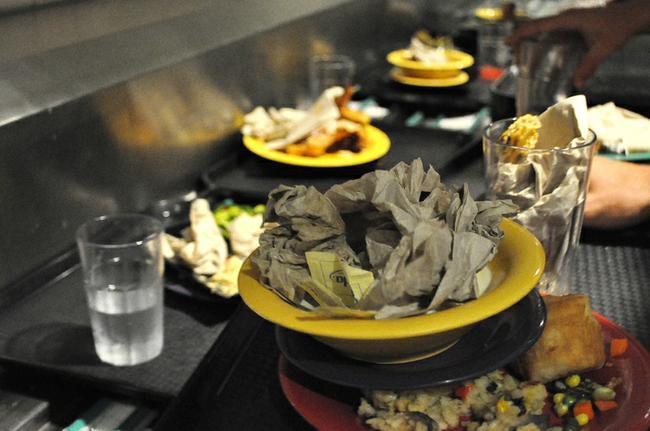
Although it’s too early to know for certain, trayless dining at MU appears to be reducing student food waste, if not conserving water in all dining halls. But the debate has not ended there.
Campus Dining Services Marketing Manager Michael Wuest met with Missouri Students Association and Residence Halls Association student leaders and CDS managing staff Tuesday afternoon to discuss the progress of trayless dining at MU, but there wasn’t much to discuss.
“We have not been able to realize any savings yet,” Wuest said. “We’re still in the measuring process. It’s only been a few weeks.”
Although CDS ran a test run of trayless dining by implementing it in Rollins dining hall for Summer Welcome, new staff needed to be trained in data collection when the semester started in August, so September will be the first full month of concrete numbers. The little data that has been collected, though, points to a decrease in student food waste, one of the program’s goals.
“We are seeing a slight decrease in the number of ounces per plate,” Wuest said. “We’re not sure how that extrapolates into large financial savings at this point.”
Students returned five to six ounces of food per plate last year, an average calculated from random samples of 100 trays at a time, weighed at lunch and dinner throughout the week, Wuest said.
Senior Plaza 900 employee Gerald Gaddy has anecdotally observed the same trend Wuest reported, but he and his coworkers have also been frustrated by the amount of work students’ sustainable intentions can cause them. At Plaza 900 and Mark Twain Market, the conveyor belts still require trays, and Gaddy said some students try to pack their plates onto one tray, with the idea of conserving energy spent in washing. Although a positive idea, it makes employees’ jobs difficult.
“It’s kind of impeded us with our dishwashing capabilities because people are putting more and more stuff on the same trays which keeps us from efficiently handling things,” Gaddy said.
Gaddy said a “one person, one tray” policy has been implied since the beginning of the year, as the added five or six pounds on a tray with multiple meals is a stress on both the conveyor belt and the workers.
This means, when students dine trayless, no trays at Plaza 900 and Mark Twain are saved a trip to the dishwasher. At Rollins, no trays are necessary to send dishes down the conveyor belt.
Louise Griggs, a full-time CDS employee who has worked at Plaza 900 since it opened, has negative feelings toward the program.
“The tray belt keeps breaking down, and you still have got to use water,” Griggs said. “I don’t see the point.”
Retrofitting the belts at the two tray-using dining halls, though, is expensive Wuest said. Only when it’s clear that trayless dining is worth the investment will CDS consider this.
CDS uses social media to receive student input for new allocation of any savings. This could be anything from new conveyor belts to extension of dining hall hours to more local meat and produce made available.
“Most of the changes we make to campus dining are really student-driven,” Wuest said. “Any service we can provide, we’re looking for student input. We think there’s a strong correlation between trayless dining and savings, but we haven’t been able to measure that at this time.”